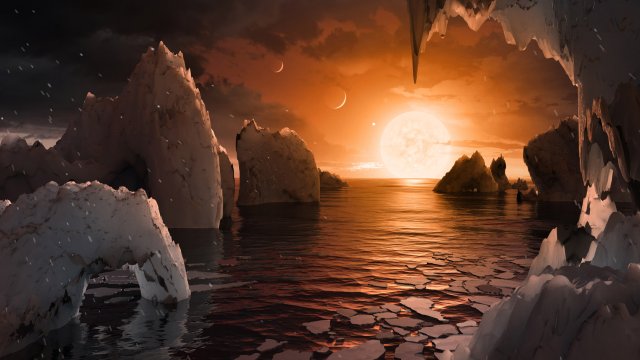Submersive

Discovery of TRAPPIST-1f
In 2019, we discovered exoplanet TRAPPIST-1f, 40 light-years from Earth. Every 9 days, It orbits TRAPPIST-1, a class-M ultracool red dwarf star in the constellation Aquarius.
Despite being slightly larger than Earth, TRAPPIST-1f has only 70% of Earth's gravity because it is 20% water by mass. By comparison, Earth is less than 1% water by mass. Located at the edge of the system's habitable zone, TRAPPIST-1f is tidally locked, meaning it has a light side and a dark side. The dark side is covered in massive glaciers, while the light side has unimaginably deep oceans, many shallow seas, and hundreds of scattered islands. The two sides meet in a narrow temperate band, known as the "terminator" zone. Viewed from space, the planet looks a bit like a giant eyeball.
The Wormhole
Also in 2019, the New Horizons space probe, while analyzing Arrokoth, a Kuiper Belt beyond the orbit of Neptune, detected an anomalous phenomenon. Further analysis showed that this object was an Einstein-Rosen bridge, commonly known as a "wormhole". We sent New Horizons through the wormhole, and it emerged in the TRAPPIST-1 system. More importantly, the probe revealed that TRAPPIST-1f had liquid oceans and a breathable atmosphere!
Kanaloa
Fifteen years later, in 2034, an aquatic probe went through the wormhole and explored the surface of TRAPPIST-1f, now renamed Kanaloa, after the Hawaiian god of the ocean. The lander found a planet teeming with life. Not just microscopic life but life very similar to our plants and animals lived in the seas, on the land, and in the air. Amazingly, collected samples showed that these lifeforms were also genetically similar to ours.

U.N.S. Zheng He
With the effects of climate change rapidly accelerating and the wealthy desperate to find a "Planet B", trillions of dollars dollars went into a project to explore the new world. The United Nations built a colony ship, U.N.S. Zheng He, and recruited thousands of volunteers to settle the new world, most of them among the richest 1%. To resist cosmic rays, the volunteers underwent pantropic genetic engineering, receiving DNA from microscopic tardigrades, as well as genes from a variety of aquatic mammals like sea otters, seals, and dolphins, to help them survive on the new world. When the Zeng He finally set off in 2050 with the passengers in ultrasound-induced hibernation, many changes to the Earth's climate were already irreversible, and construction of a second colony ship was underway.
Splashdown
Fifteen years later in 2065, the ship passed through the wormhole, and the passengers came out of their deep sleep. Drop ships and supply pods went down into the terminator region, and people began building new lives for themselves. The Zheng He turned around and headed back toward Earth to pick up another wave of colonists.
Xenotech
Things went smoothly until the arrival of the second colony ship, the UNS Robert Ballard, in 2075. A dredging operation to build an artificial island turned up evidence of an ancient alien civilization. Seemingly "primitive" tools composed of rocks, sticks, and bones made use of nanotechnology far surpassing anything created by humans. This xenotech could do things like control the weather, read minds, or even see into the future. Mere exposure to it gave some people superhuman abilities.
As soon as people began digging for these artifacts, things went wrong almost immediately. Entire salvage teams vanished, only to be found dead on a distant island, or washed ashore with amnesia. Transport ships suffered catastrophic hull failure. Corporate offices mysteriously caught fire. People blamed the "psychics". But then things got worse.
Second Sun
When the Zang He returned through the wormhole in 2096 with the third wave of colonists, powerful solar flares emerged from the wormhole, incinerating the ship and all of Kanaloa's communication and GPS satellites. Electromagnetic waves fried electronics planet-wide. Flaming wreckage fell from the sky for days, and though the flares weakened, they did not stop. The "second sun" lit up the skies of Kanaloa, changing the climate. The ice on the dark side started to melt.
The Vodyanoi
At the same time, creatures described by survivors as vodyanoi (fish-demons) emerged from the waters around a Russian colony. Displaying powers of their own, they captured every known psychic in the colony, and dragged them into the ocean. The fate of the victims is unknown.

Dive, Salvage, Survive
With the other end of the wormhole seemingly pointed at a star, Kanaloa is cut off from Earth. The rapidly rising sea levels will eventually cover all the remaining islands. Without any supply ships, your technology is starting to break down. Hopefully, there's enough wreckage out there to build a functional spacecraft, get into orbit, and figure out how to reverse the problem. Then again, maybe the real solution is beneath the waves...